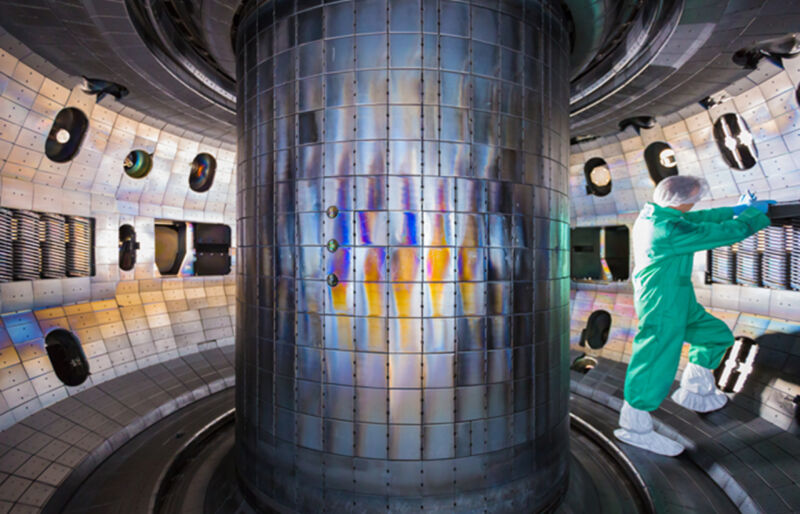
Using nuclear fusion, the process that powers the stars, to produce electricity on Earth has famously been 30 years away for more than 70 years. But now, a breakthrough experiment done at the DIII-D National Fusion Facility in San Diego may finally push nuclear fusion power plants to be roughly 29 years away.
Nuclear fusion ceiling
The DIII-D facility is run by General Atomics for the Department of Energy. It includes an experimental tokamak, a donut-shaped nuclear fusion device that works by trapping astonishingly hot plasma in very strong, toroidal magnetic fields. Tokamaks, compared to other fusion reactor designs like stellarators, are the furthest along in their development; ITER, the world’s first power-plant-size fusion device now under construction in France, is scheduled to run its first tests with plasma in December 2025.
But tokamaks have always had some issues. Back in 1988, Martin Greenwald, a Massachusetts Institute of Technology expert on plasma physics, proposed an equation that described an apparent limit on how dense plasma could get in tokamaks. He argued that maximum attainable density is dictated by the minor radius of a tokamak and the current induced in the plasma to maintain magnetic stability. Going beyond that limit was supposed to make the magnets incapable of holding the plasma, heated up to north of 150 million degrees Celsius away from the walls of the machine.
Since the power output of a tokamak was proportional to the square of fuel density, this limit didn’t bode well for fusion power plants. A commercial reactor would either need to be huge or drive absurdly high plasma currents. The former meant it would be catastrophically expensive to build, and the latter that it would be expensive to run.
But there has been hope. Since then, many research teams working at different tokamak facilities—including the Joint European Torus (JET) in Britain or ASDEX Upgrade in Germany—achieved plasma densities exceeding the Greenwald limit. In response, Martin Greenwald himself revised his claim a bit, saying that the limit applied not to the line averaged plasma density in the entire reactor but only to the portion of the plasma occupying less than 10 percent of the radius near the reactor’s wall.
While the actual density numbers were pushed a little, the working principle behind the Greenwald limit still held—when the plasma density went up above the Greenwald line, the quality of confinement went down. “The major phenomenon people discovered in the high-density experiments was reduced energy confinement when plasma density was increased,” said Siye Ding, a researcher at General Atomics working at the DIII-D National Fusion Facility.
To use fusion for energy production, we need both high density and high confinement. “For the first time, we have experimentally demonstrated how to resolve this problem,” said Ding.
Self-organizing puzzle
“When you make a plasma in your reactor, there is a whole combination of parameters,” explained Andrea Garofalo, a sciences manager at General Atomics who worked on the experiment at DIII-D. “What is the plasma current, what is the toroidal field, what is the external heating versus time. Combinations of such parameters can vary in tokamaks—you can have plasma current higher or lower, you can start the heating early, you can start it later. All this comprises what we call a scenario.”
“We’re talking about optimizing the waveforms of power, fueling, etc. to achieve the right configuration,” he added.
The configuration he and his colleagues achieved (called the high-poloidal-beta scenario) worked like a charm.
People working on nuclear fusion use various metrics that integrate multiple parameters into simple numbers to make it easier to compare the performance of different fusion experiments. The H98Y metric tracks the quality of confinement. The high confinement mode that will be used at ITER has H98Y equal to 1. Plasma density is often denoted as FGR—the Greenwald fraction—which describes how far below or above the Greenwald limit plasma density can get. FGR equal to 1 means density exactly at the Greenwald limit.



3175x175(CURRENT).thumb.jpg.b05acc060982b36f5891ba728e6d953c.jpg)

Recommended Comments
There are no comments to display.
Join the conversation
You can post now and register later. If you have an account, sign in now to post with your account.
Note: Your post will require moderator approval before it will be visible.